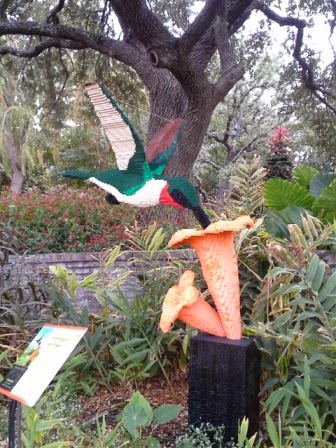Posted by Linda McMulkin, CSU Extension-Pueblo County
When I travel, I love to visit public gardens and often make
time to visit the major botanical garden in the area.
And I’m always looking for fun ideas for yard art. While in San Antonio for New Years, I found
yard art that I’d love to make at home, if only I could find the materials.
 |
| A full sized Lego lawnmower |
Our visit coincided with a cold front that left snow in
Colorado, black ice in north Texas, and cool, wet days in the San Antonio
area. After a enduring a day at tourist spots
filled with people in town for the holiday and Alamo Bowl, my husband and I
wanted to find a quiet place. We arrived
at the San Antonio Botanical Gardens just as a light rain began to fall, so we donned our raincoats
and set forth.
 |
| This sculpture took over 30,000 Lego blocks to build. The hummingbird was nearly 3 feet long. |
 |
| This Lego gardener picked a chilly day to be hoeing the garden. |
 |
| I loved this Lego oak acorn that germinated under a mature live oak. |
The grounds were lovely, the greenhouses filled with fascinating plants, the children’s community garden amazing, the native ecosystem displays informative, and the water-wise landscape tips educational. But the thing that kept Mike and me moving from garden to garden was the search for Lego sculpture.
 |
| Predator/prey relationships was the theme of this sculpture. The fox took 17,547 pieces to build and the rabbit 1,361. |
My kids played with Lego when they were young and I have the typical parent memories of building fantastic structures with Lego and of stepping on pieces in the middle of the night. I passed the Lego collection on to other kids when my girls lost interest, but seeing this exhibit made me want all those tiny toys back. Of course, those pieces would have been only a small percent of the Lego needed to build the sculptures in San Antonio. But, if I had 40,000 red Lego blocks, what might I create?
 |
| This rose, placed in the still blooming rose garden, took over 40,000 Lego pieces to build. |
The Lego sculpture exhibit at San Antonio Botanical Garden ended
just after our visit, but you can find this traveling exhibit at other gardens
in the next few years. The artist’s website,
http://www.seankenney.com/portfolio/nature_connects/, lists the Denver Zoo as
an upcoming site, from August 7 to November 1, 2015. I’ll definitely have to take another road
trip!








.JPG)








